Revolutionary New Honda EV
In a first-ever technology pairing for series production, Honda is mating plug-in battery electric and hydrogen fuel cell electric in the all-new 2025 CR-V e:FCEV. This breaks the norm of a fuel cell vehicle run solely on hydrogen or simply with a battery for energy storage. The e:FCEV advances Honda’s emissions goals as the company marches to 100-percent zero emission vehicles (battery electric or fuel cell electric) by 2040. For all operations, the company aims to reach carbon neutrality by 2050.
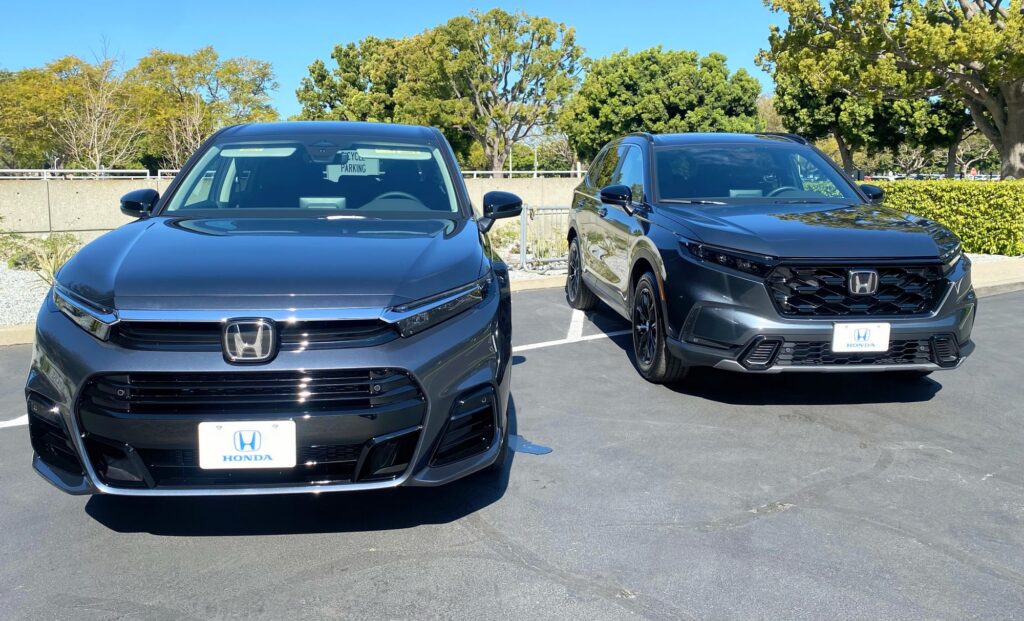
Honda’s Electric and Hydrogen History
Honda has a solid track record of developing, and releasing into (mostly limited) production, hybrid electric vehicles (HEV), plug-in hybrid vehicles (PHEV), battery electric vehicles (EV), hydrogen fuel cell electric vehicles (FCEV), and their latest innovation, a plug-in electric hydrogen fuel cell electric vehicle (e:FCEV.) This is a history, with an * next to models currently in production.
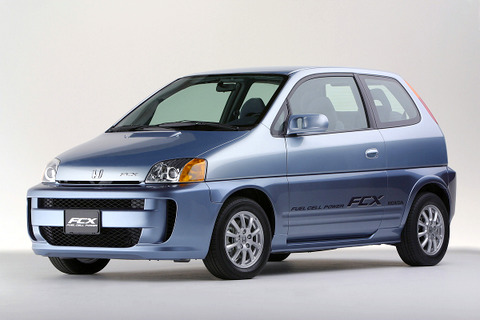
- EV Plus 1997-99
- Insight Hatchback Hybrid 1999-2006
- Civic Hybrid 2003-* (offered intermittently in various generations of Civics starting with the 7th generation in 2003; note: An all-new Civic Hybrid will be released in 2025.)
- FCX Hatchback FCEV 2002-07
- Accord Hybrid 2005-*
- FCX Clarity Hatchback FCEV 2008-14
- Fit Hatchback EV 2013
- Accord PHEV 2014 only
- CRZ Hybrid 2011-16
- Clarity FCEV 2017-21
- Clarity Electric 2017-19
- Clarity Plug-in Hybrid 2017-21
- Insight Sedan Hybrid 2010-14; 2019-22 (two models)
- CR-V Hybrid 2020-*
- HR-V Hybrid 2020-*
- Prologue EV 2024-*
- CR-V e:FCEV (plug-in hydrogen fuel cell electric) 2025-*
Honda’s “Triple Action to Zero” Environmental Plan
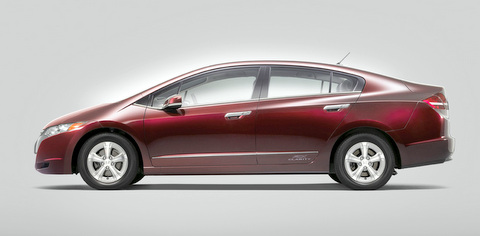
Honda has implemented a “Triple Action to Zero” plan, which includes its products and corporate activities, working towards a carbon-neutral standing.
- Carbon neutrality for all Honda products and corporate activities by 2050.
- Using 100-percent sustainable materials, enabling Honda to recycle or reuse all materials from its vehicles.
- Clean Energy, including electrification and hydrogen for the company’s operations and vehicle production.
Introduction: The All-New 2025 CR-V e:FCEV
The 2025 CR-V e:FCEV, a hybrid hydrogen-powered fuel cell and plug-in electric vehicle, will have a 270-mile all-electric driving range (AER) with its 92.2 kW electric motor powered by electricity from its hydrogen fuel cell (fed by up to 4.3 kg of hydrogen). It also has up to 29 miles of range coming from the 17.7 kWh battery that can be fed by plugging in. Both systems can power the car independently, so if either the electricity or hydrogen are low, you won’t be stuck on the side of the road.
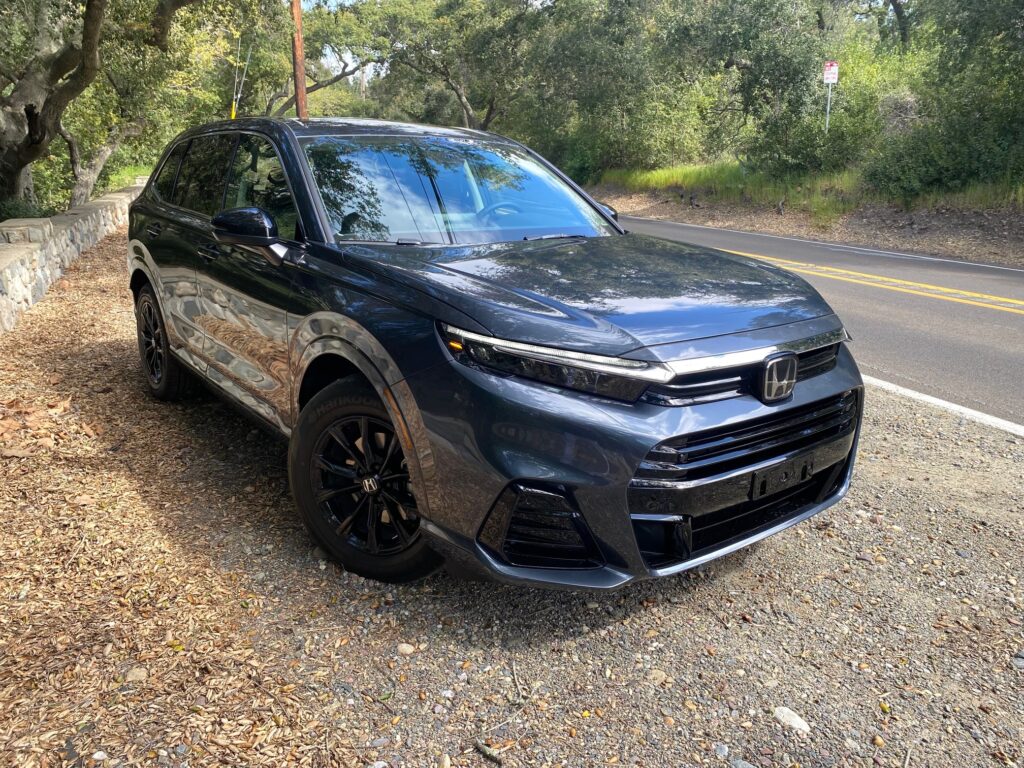
Through a chemical process, the fuel cell uses hydrogen and oxygen to create electricity to power the motor and charge the lithium-ion battery. The only by-product is water vapor that harmlessly drips from the tailpipe, making the e:FCEV a zero-emission vehicle.
The e:FCEV’s plug-in battery charges in less than two hours with a 240V EV charger, or about 10 hours using a common 120V household plug. DC Fast Charging is not available. Charging nightly and driving less than 29 miles will mean less need for hydrogen fuel, which is currently available at only about 50 stations in California.
MPGe fuel economy is rated at 61 mpg city/52 highway/57 combined using the electric battery and compressed hydrogen fuel. MPGe is a measurement of how far a car can travel electrically, on the same amount of energy as is contained in 1 gallon of gasoline.
The closest comparisons for hydrogen-only cars are the Toyota Mirai and Hyundai Nexo.
Short Drive
Honda invited automotive journalists to drive the e:FCEV on a short loop near its Torrance, California, headquarters. Key remarks from Jay Joseph, VP sustainability, confirmed Honda’s “long-term investment and 40 years of experience” in electrification, and its quest to “make hydrogen more accessible” to the public.
The e:FCEV’s performance from the 174-horsepower/229 pound-feet of torque electric motor was 8.5 seconds in 0-60 mph runs. While not fast by EV standards, it will get the job done for entering freeways, which is what the e:FCEV will be doing a lot of as it will only be leased in California when it hits dealers in late 2024.
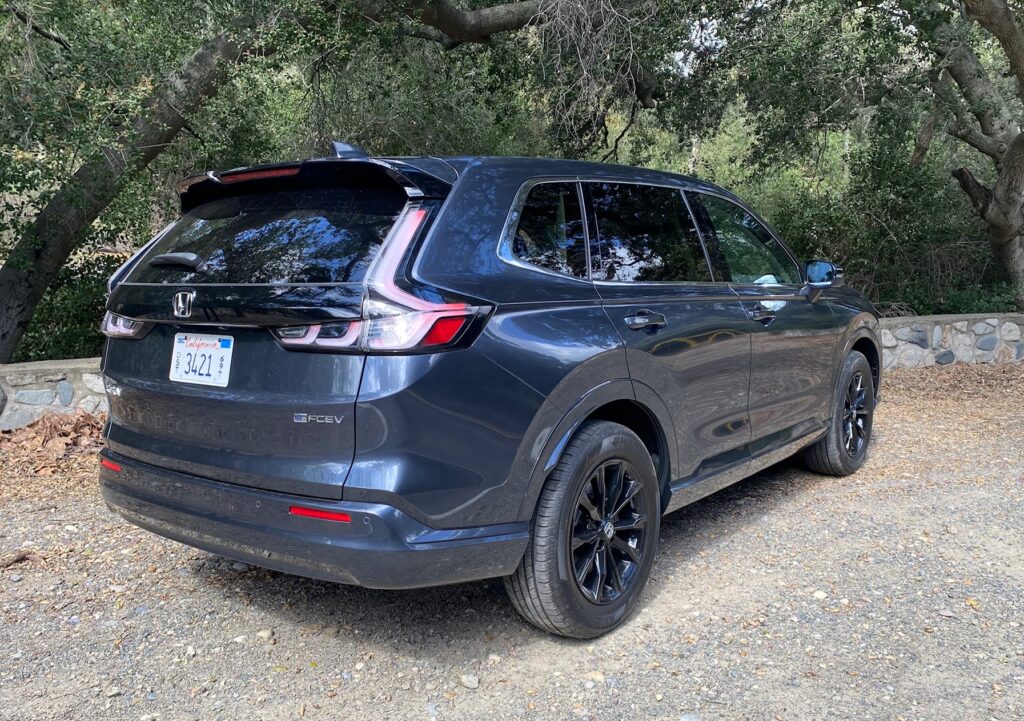
Of the drive modes of Normal, Eco, Sport and Snow, Normal and Sport are our favorites for accelerator feel and performance. On the freeway with consistent 65+ mph cruising, we may have opted for Eco. With the e:FCEV a California-only car, the Snow mode will not be called on too often.
To provide a basis for comparison, Honda let us first drive a 2024 CR-V Hybrid that weighed 500 pounds less than the e:FCEV. The weight difference was noticeable, but not in a bad way as the extra heft gave a solid feel to the fuel cell model’s ride, aiding stable handling. Braking on the e:FCEV was a bit longer than the hybrid due to the added weight, but once understood, adjusting for it was not an issue. Our limited time behind the wheel was on city streets with no corners to attack, which is perfectly fine as Honda is not marketing the e:FCEV as a sport SUV.
There will be a more detailed review of the driving impressions, posted just before the CR-V e:FCEV comes out later in the year. Make sure to opt-in to the Clean Fleet Report newsletter (top right of page) to be notified of all new stories and vehicle reviews.
Contemporary Design/Comfortable Interior
Design-wise, the CR-V e:FCEV and the CR-V Hybrid are similar. Subtle-but-obvious differences are the e:FCEV is 3-inches longer, the front end is sleeker with a smaller upper grille and different lower front and rear fascia. Narrow headlights leading to a longer hood, new vertical tail lights and 10-spoke 18-inch black wheels differentiate the e:FCEV.
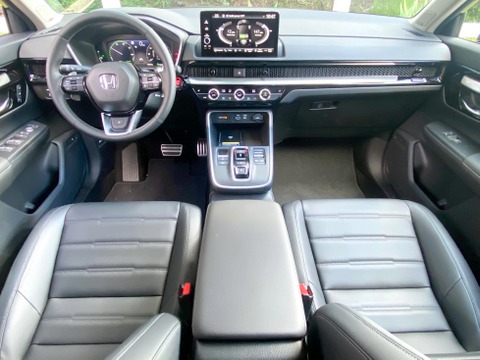
The CR-V e:FCEV comes in one trim level—Touring. The driver and passenger seats are heated, with power adjustments. The cockpit design is similar to the CR-V Hybrid with a 10.2-inch digital vehicle information screen and a 9.0-inch HD touchscreen for the 12-speaker Bose audio system with Apple CarPlay and Android Auto.
Overall, the build quality was at a high level. The honeycomb pattern dash panel, soft surfaces on the dash and door panels, wireless phone charging, heated steering wheel, dual zone climate control, and hands-free power lift gate made for a welcoming cabin. The shift-by-wire gear selector, located in the center console, opens space over a conventional shift lever.
The rear seats are made for grown humans: ample leg, shoulder and head room for two comfortably, but three for short jaunts, although you lose the fold down armrest with cup holders. While the rear seat folds 60:40 for storage, the space is compromised a bit as the hydrogen storage tanks are placed under the rear seat.
Safety
All CR-V models come standard with active and passive safety features such as front and side air bags. Honda Sensing, their advanced driver assistance systems, or ADAS, includes safety technologies of forward collision and road departure mitigation, lane keep assist, and adaptive cruise control.
Pricing and Availability
Honda will announce prices for the 2025 CR-V e:FCEV closer to when it goes on-sale in late 2024. It will qualify for federal and California tax credits, as well as the coveted HOV sticker that allows for a single driver to use the carpool lane, though that may only be good for a short while as that program is due to sunset.
Hydrogen Considerations
- Hydrogen costs (as of April 2024): $36 per kilogram (kg), so the e:FCEV’s 4.3 kg tank will cost about $155 to fill. It takes about five minutes to fill the tank.
- Hydrogen fuel stations, just like electric charging stations, have a spotty record of not being operational at all times. This is why it is crucial to use an availability website, such as the one from the Hydrogen Fuel Cell Partnership.
- Hydrogen prices fluctuate in a broader range than gasoline or electricity. In 2022 it was $16 per kilogram compared to now where it sits around $36 per kilogram.
- Versus an electric car, the cost of fueling difference is substantial. The cost to charge an electric car with a 66 kWh battery, with a California average of 19.39¢ per kilowatt hour for electricity, would cost about $12 to drive 300 miles, which is a common all-electric range found on many EVs. That compares to the 270 AER of the CR-V e:FCEV. With a home charger and solar panels, the cost to charge an EV would be even less.
- The e:FCEV is not a car that currently can be driven outside California.
The State and Future of Hydrogen
There are only 55 operating hydrogen fuel stations in California, and the availability of hydrogen is sometimes spotty. For perspective, China, which is far larger than California, has 250 stations and Japan, which is roughly the same size as California but populated by three times as many people, has 160 stations.
The state has recognized hydrogen-powered cars as part of its drive to zero-out tailpipe emissions (and the resulting dangerous smog) for three decades and helped support the development of vehicles and infrastructure. The hydrogen fueling station network slowly being built out, funded in part with state support that averaged $20 million/year for the past couple decades.
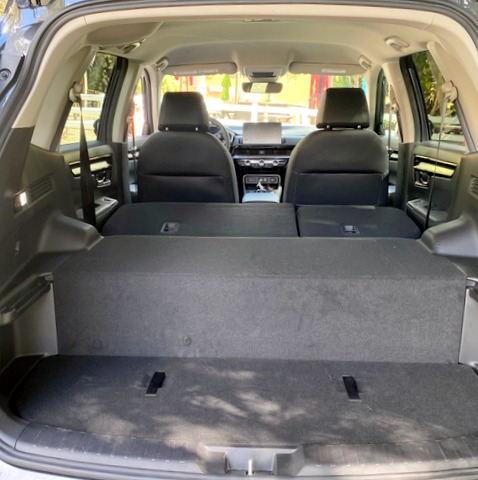
In October 2023 Gov. Newsom signed a funding bill to invest $106 million in the construction of additional hydrogen stations through the end of the decade, for the first time backing stations for commercial vehicles as well as passenger cars. The need for more stations is necessary if this fuel is to ever gain consumer acceptance for their everyday vehicles.
Honda is betting (and investing big) in hydrogen fuel. In addition to the 2025 CR-V e:FCEV for consumers, Honda Motor Company and Isuzu Motors Limited are branching into the area of commercial vehicles. The Giga Fuel Cell, a zero-emissions FCEV heavy-duty truck with an estimated 500 mile range, was shown for the first time at the Japan Mobility Show 2023. Projections are to introduce a production model in the Japan market in 2027.
Honda has created a proof-of-concept Class 8 hydrogen fuel cell truck in the U.S., while its rival Toyota has demonstrated the 300-mile range truck in a joint project with Kenworth. PACCAR, Kenworth and Peterbilt’s parent company, is working with Toyota to offer a production fuel cell truck.
Honda also will take initiative to apply its fuel cell system to construction equipment such as excavators and wheel loaders, offering the construction industry a path to carbon neutrality.
Observations: 2025 Honda CR-V e:FCEV
The Honda CR-V compact crossover utility vehicle (CUV) has been one of the most popular CUVs in America and accounts for more than 56-percent of Honda’s CUV/SUV sales and a third of all the brand’s sales. Updates since its debut in 1997 have included the first ever CR-V Hybrid in 2020. Next up is the all-new 2025 CR-V e:FCEV that will be released in late 2024.

The 2025 Honda CR-V e:FCEV will only be leased in California, and just 300 are committed to being built annually. Compared to its FCEV competitors (that are also only sold or leased in California), the Toyota Mirai (357-to-402 AER) and Hyundai Nexo (354 AER), it has a lower overall driving range. But those models don’t have a plug.
The key to making the 2025 Honda CR-V e:FCEV work (and its ace in the hole) for your budget and convenience, will be home charging, then using the 29-mile all-electric driving range to its fullest whenever possible. If your driving is close to home, the Honda CR-V e:FCEV may be a better hydrogen fuel cell electric vehicle option.
Honda’s market test of the e:FCEV is to show how a plug-in hydrogen fuel cell vehicle operates in the real world to see whether it will be accepted by the public. They couldn’t have done it in a better place where Californian’s are EV-savvy and EV-crazy.
It will be built by hand in Marysville, Ohio, at Honda’s Performance Manufacturing Center, the same facility that hand-built the very sporty Acura NSX.
Make sure to opt-in to the Clean Fleet Report newsletter (top right of page) to be notified of all new stories and vehicle reviews.

1 thought on “News: 2025 Honda CR-V e:FCEV”